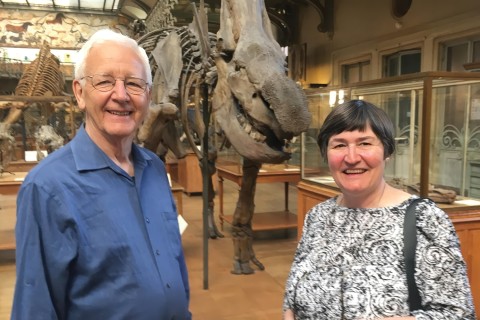Imagining scripture: A rich reservoir of ancient and contemporary conversation partners
It seems to me a wonderful irony that Christians in America are preoccupied with debates about biblical authority just when all parties to the debates are less knowledgeable about the content of scripture than many of our predecessors were. On college campuses, teachers of English literature find it difficult to teach texts like Paradise Lost, Moby Dick or Toni Morrison’s Beloved because students are unable to grasp the biblical allusions. In churches, preachers comment on the lack of biblical literacy among their parishioners, and the pastors’ comments sometimes deflect attention from their own illiteracy.
This lack of familiarity with scripture weakens our capacity for theological reflection, moral discernment and spiritual nurture. It also impoverishes our vocabulary for characterizing God, the world and the purpose and destiny of our lives.
Yet, troubling as biblical illiteracy may be, I am even more troubled by our lack of imagination and sophistication in interpreting the whole story of scripture. As my colleague David Steinmetz said, “We are better readers of detective fiction than we are of scripture.” He noted that reading scripture well is a lot like reading detective fiction—what you discover later in the story equips you to see the earlier parts with fresh and illuminating eyes.
Steinmetz understands these connections because he has devoted much of his career to interpreting our forebears’ interpretations of scripture. He has discovered a sophisticated, imaginative conversation that is more like contemporary approaches to detective fiction or other novels than what we have come to call “exegesis.”
Could it be that we know less of the content of scripture because we have made it so boring? We flatten scripture when we read the text only for what lies behind it, or in segments or as a collection of guidelines for moral living. Who wouldn’t rather reread Beloved than study a series of texts that we cannot connect to a larger narrative, much less to our convictions about the Triune God whom we worship?
I am not saying that we should ignore the gains in understanding that have been achieved by the “higher criticism” of the past two centuries. We need the best philological and historical methods we can develop. But we also need to learn how to read imaginatively, how to move back and forth both intratextually and intertextually.
This became clear to me in reading Gary Anderson’s book The Genesis of Perfection: Adam and Eve in Jewish and Christian Imagination. Anderson takes on those vexing opening chapters of the Bible, Genesis 1-3. But he does so by exploring how the modern debates have been received by interpreters in both Jewish and Christian thought.
The book is a sheer delight. It has altered my thinking about how best to interpret the story of Adam and Eve, and it extends an invitation to scripture that is far more engaging, imaginative and theologically illuminating than what we hear in most synagogues or churches. Anderson makes the story come alive, both in its particulars and in its larger implications.
He takes us on an elegant journey that includes the rest of scripture, patterns of interpretation by rabbis and Christian theologians in the early postbiblical era, the art of Michelangelo and the fiction of John Milton. The continual retelling of the Adam and Eve story, he explains, illumines, challenges and transforms “conventional” understandings of its original context. He also shows how liturgical settings, artistic renderings and scholarly commentary are typically interwoven in a rich and complicated conversation.
Anderson’s invitation to that conversation encourages us to become sophisticated and imaginative readers. He writes:
The story of Adam and Eve is very, very short. The story of Joseph and his brothers is easily ten times as long if not longer. Yet the very brevity of the [Adam and Eve] tale, along with the knotty questions it leaves unanswered, cries out for some sort of interpretive expansion. Jewish and Christian readers set about to fill in these gaps by correlating them to other parts of the biblical story. Like readers returning to the opening pages of a novel, they reread—and eventually rewrote—the story of human beginnings in light of where they believed them to point.
How can we learn to weave together the insights of philological and historical investigation—exegesis—with the imaginative readings of our forebears? I took a first step by participating in seminars sponsored by the Center of Theological Inquiry. A group of 15 people made up of biblical scholars, historical theologians, systematic theologians and pastors gathered to read scripture together. Steinmetz noted that, collectively, we represented the skills a single interpreter would have been expected to have in earlier eras.
It took us a while to stop protecting the turf of our disciplines. But once we did, we began to see connections—and to discover interpretive partners both ancient and contemporary—that made reading scripture more imaginative, more fun and more theologically significant than it had been before. As a result, I have learned more about the content of scripture and become more supple in my judgments about its authority. Best of all, I’ve learned that there is a rich reservoir of ancient and contemporary conversation partners who can aid us all in the art of reading, interpreting and imagining scripture.




